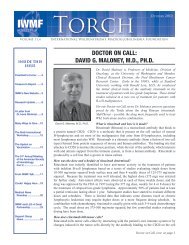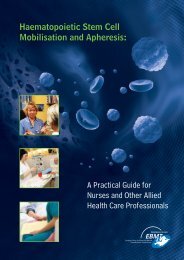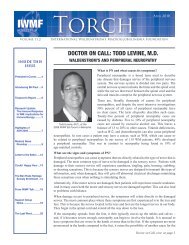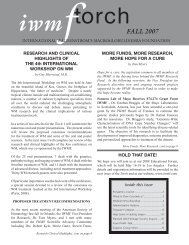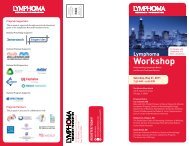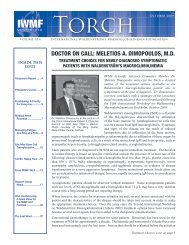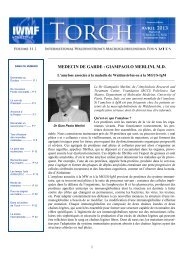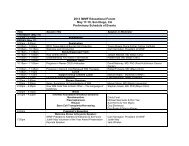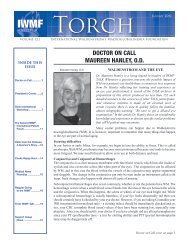English - International Waldenstrom's Macroglobulinemia Foundation
English - International Waldenstrom's Macroglobulinemia Foundation
English - International Waldenstrom's Macroglobulinemia Foundation
You also want an ePaper? Increase the reach of your titles
YUMPU automatically turns print PDFs into web optimized ePapers that Google loves.
Doctor on Call cont. from page 2<br />
some manifestations of amyloidosis are already part of the<br />
clinical picture of Waldenström macroglobulinemia (for<br />
example fatigue and shortness of breath due to anemia or<br />
peripheral neuropathy due to the antibody activity of the IgM<br />
versus certain components of the nerve tissue). Therefore<br />
patients and physicians should be especially alert in order to<br />
detect promptly any clinical manifestations possibly related<br />
to amyloidosis.<br />
Is it possible to diagnose the presence of amyloid early,<br />
before severe organ damage has occurred?<br />
Most of the clinical manifestations described above appear<br />
when the damage to the target organ is already advanced and<br />
sometimes irreversible. Manifestations of nerve involvement<br />
may appear rather early, but the heart (the most crucial organ<br />
on which our survival depends) and the kidneys are usually<br />
damaged silently until they become unable to function<br />
properly and become symptomatic. Fortunately, we can<br />
monitor both the heart and kidney functions using widely<br />
available biomarkers that can detect promptly the damage<br />
caused by the amyloid process, even several months before<br />
the appearance of symptoms. When the heart is stressed, it<br />
produces a hormone called “B natriuretic peptide” (BNP)<br />
and its fragment called NT-proBNP, which we can measure<br />
in the blood. It is now well established that these markers<br />
are extremely sensitive to cardiac amyloid infiltration,<br />
which they can detect in the very early stage, even though<br />
the markers can also be indicative of other primary cardiac<br />
diseases, such as atrial fibrillation or coronary disease. We<br />
would recommend that BNP or NT-proBNP be measured<br />
at least once a year, particularly in individuals with IgM<br />
monoclonal protein and high levels of free light chains in<br />
the blood with an abnormal free light chain ratio. If the level<br />
of these biomarkers is elevated, a careful evaluation by a<br />
cardiologist and echocardiography can help to detect possible<br />
early amyloid cardiac damage. Effective therapies can then<br />
be started promptly. Kidney involvement can be detected<br />
early by measuring both the level of albumin in the urine<br />
and the level of serum creatinine and then estimating the<br />
creatinine clearance by employing an established formula.<br />
These measurements should also be performed at least once<br />
a year in individuals with a serum monoclonal IgM.<br />
In the presence of clinical manifestations or increased<br />
level of cardiac and renal markers indicating the possible<br />
presence of light chain amyloidosis, rather simple diagnostic<br />
procedures should be promptly pursued. Since amyloidosis<br />
is characterized by the deposition of fibrillar protein, the<br />
diagnosis relies on the documentation of such deposits<br />
in tissues. The most accessible tissue is the fat around the<br />
navel that can be easily and painlessly aspirated using a fine<br />
needle. Specific staining can document the presence of the<br />
amyloid deposits in almost 90% of patients. In the remaining<br />
10% who do not show deposits but have the disease (false<br />
negatives), it is possible to search for deposits using a biopsy<br />
of the labial salivary glands that identifies amyloidosis in an<br />
additional 5% of patients. Certain clinical centers may use<br />
rectal biopsy, and that is also useful. If all these biopsies<br />
are negative, while the clinical suspicion of amyloidosis is<br />
strong, then it is possible to biopsy the affected organ, usually<br />
the kidney or the heart.<br />
Once the amyloid deposits have been documented, it is<br />
important to make sure that they are formed by light chains<br />
in order to institute the appropriate treatment. As reported<br />
above, a significant number of proteins can form amyloid<br />
deposits. For instance, in rare cases (approximately 5%) of<br />
patients with Waldenström macroglobulinemia, the amyloid<br />
deposits are not formed by light chains but by another protein<br />
called serum amyloid A (SAA) that increases markedly in<br />
the blood when there is a chronic inflammation. This type of<br />
amyloidosis (reactive or secondary amyloidosis) requires a<br />
distinct therapeutic and monitoring approach. Furthermore,<br />
in an elderly patient with isolated cardiac involvement and<br />
an IgM spike, it is wise to exclude amyloidosis related to<br />
aging (senile systemic amyloidosis) since it requires a<br />
different therapy. If the cardiac involvement is associated<br />
with involvement of the peripheral nerves, familial amyloid<br />
polyneuropathy (FAP) should be excluded. The determination<br />
of the type of protein constituting the amyloid deposits<br />
requires a specialized approach by amyloid referral centers,<br />
and your doctor should guide you in this process.<br />
Is amyloidosis treatable?<br />
Light chain amyloidosis is a treatable disease, with impressive<br />
survival benefit in responding patients. The most effective<br />
therapy, at present, is the suppression of the synthesis of<br />
the misfolded monoclonal light chains through anti-clonal<br />
chemotherapy; hence the therapies used for Waldenström<br />
macroglobulinemia are also effective for the treatment of this<br />
severe complication. In the presence of amyloid, however,<br />
rapidly acting agents are preferred since it is vital to suppress<br />
the production of the toxic light chains as soon as possible.<br />
The intensity of the therapies may be limited by the presence<br />
of heart dysfunction caused by amyloidosis. In relatively<br />
young patients without significant heart damage, autologous<br />
stem cell transplantation may be considered. Treatment<br />
should be carefully monitored with frequent evaluation of<br />
the level of serum free light chains and of markers of heart<br />
(using NT-proBNP) and kidney (using urinary albumin level<br />
and serum creatinine) function.<br />
In patients who achieve complete suppression of the amyloid<br />
light chains and improvement in the level of cardiac or renal<br />
biomarkers, survival is greatly extended. It is very important<br />
to sustain the function of the damaged organs with supportive<br />
therapy while chemotherapy is producing its beneficial<br />
effects. Coordinated collaboration of specialists is necessary<br />
to provide the best possible supportive care. Cardiologists<br />
Doctor on Call cont. on page 4<br />
IWMF TORCH Volume 14.2<br />
3



